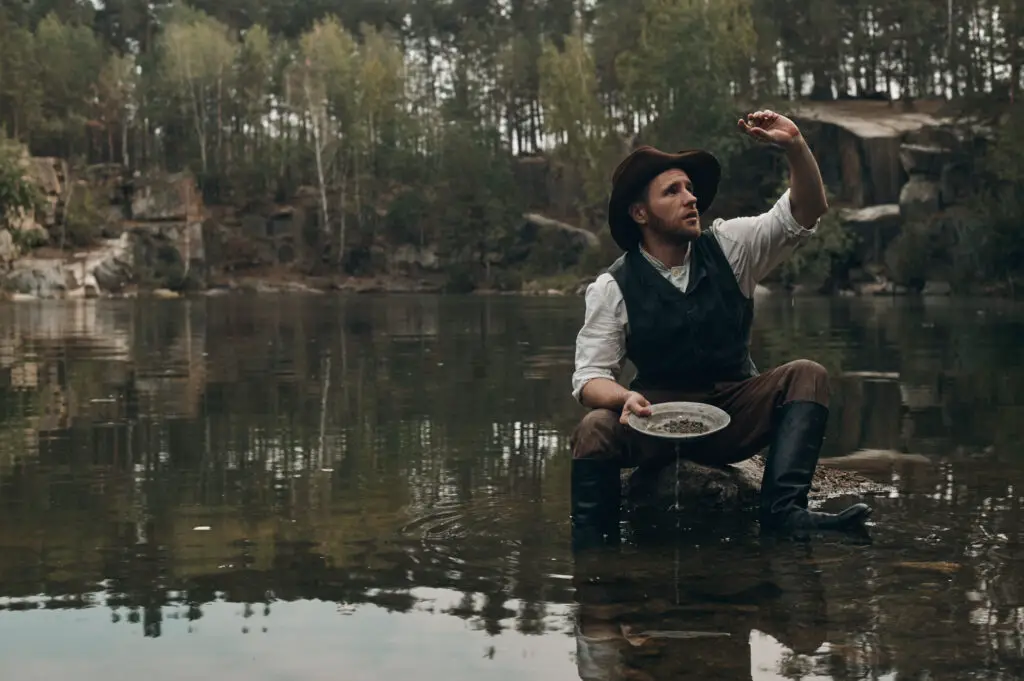Have you ever dreamt about unearthing a glittering gold nugget, harking back to the golden age of prospecting? Does the notion of finding your fortune, not in the gleaming towers of a cityscape, but in the serenity of nature, appeal to your adventurous spirit? If the answer to any of these questions is a resounding “yes,” then join us as we journey to the farthest reaches of the land down under, to Tasmania, an island state off Australia’s south coast teeming with untapped potential and golden opportunities.
Tasmania, a treasure trove of natural wonders, stunning landscapes, and rich history, has been quietly guarding its golden secret, only revealed to those willing to brave the wilds and get their hands a little dirty. From the tumultuous waters of the rivers and streams to the quieter locations where mineral-rich deposits lay undisturbed, Tasmania offers both the novice prospector and the seasoned gold hunter plenty of opportunities to find this precious metal.
The Gold Rush may be over, but that doesn’t mean the gold is gone. In Tasmania, echoes of these bygone eras still linger, and with the right knowledge, equipment, and a dash of luck, you might strike it rich, or at least uncover an exciting hobby and an extraordinary adventure.
In this blog, we’ll explore some of the most lucrative places to pan and find gold in Tasmania, share tips from experienced prospectors, and guide you through the processes and regulations involved in this exciting pursuit. From the historical goldfields of the northeast to the lesser-known locales further afield, we’ll reveal Tasmania’s glittering secrets and show you that the pursuit of gold is as much about the journey as it is about the treasure at the end.
So dust off your gold pans, put on your adventurer’s hat, and follow us on this golden journey. Tasmania awaits!

Where Has Gold Nuggets Been Found In The Past In Tasmania?
Gold has a long history in Tasmania, with several significant discoveries having been made in various parts of the state since the start of the gold rushes in the mid-19th century. Here are some areas in Tasmania where gold nuggets have been found in the past:
Mathinna: The Mathinna goldfield was once the richest gold mining area in Tasmania. The field was discovered in 1871, and the township quickly became the state’s third largest. The area, known for its alluvial gold, was mined until the early 20th century and continues to produce gold to this day, with prospectors often finding smaller nuggets and gold flakes.
Lefroy: Located in the northeast of Tasmania, Lefroy was a significant gold mining field in the 19th century. One of Tasmania’s primary gold producing areas, Lefroy, yielded both alluvial and reef gold. The field is still a popular spot among prospectors.
Beaconsfield: Notable for its gold mine that operated until the early 21st century, Beaconsfield is a town steeped in gold mining history. Gold was first discovered in Beaconsfield in 1847, but the real rush didn’t start until 1877 when the Tasmania Gold Mine opened. The mine was one of the richest gold mines in Tasmania.
Corinna and the Pieman River: The region around the Pieman River yielded significant alluvial gold in the late 19th century. Gold was found both in the river itself and in many of its tributaries. Corinna was the center of this gold mining activity.
Queenstown and the West Coast: Tasmania’s West Coast has a rich history of mining, including gold mining. While more famous for its copper mines, several significant gold mines have operated in the area, especially around Queenstown.
Mount Victoria and the Fingal Valley: Mount Victoria and the Fingal Valley area in Northeast Tasmania was a significant gold mining area in the 19th century.
Please note that if you plan to go prospecting, you will need a Prospecting License from the Mineral Resources Tasmania, as fossicking without a license is illegal in Tasmania. Also, respect the land and the environment, and ensure that you fill in any holes you dig.
What Is The Biggest Gold Nugget Found In Tasmania?
While Tasmania has a rich history of gold mining and prospecting, detailed records of individual nugget discoveries are not as extensively documented as in some other gold-rich areas like Victoria. However, it’s known that Tasmania has produced some significant nuggets throughout history.
One of the most famous nuggets found in Tasmania was discovered at Rocky River near Corinna on the west coast of Tasmania. Known as the “Welcome Stranger of the West,” it was discovered in 1897 and weighed in at an impressive 243 ounces (approximately 6.9 kilograms).
It’s worth noting that while prospectors may still find gold nuggets in Tasmania today, most are likely to be considerably smaller than the large nuggets found during the height of the gold rush in the 19th century. Today, prospecting in Tasmania is more about the adventure and excitement of the hunt rather than the expectation of striking it rich.
Best Rivers To Pan For Gold In Tasmania
Here are a few of the best rivers to pan for gold in Tasmania:
The Mersey River: Flowing from the Lake District and emptying into Bass Strait at Devonport, the Mersey River and its tributaries have been fruitful for prospectors, particularly around Mole Creek and Kimberley.
The Ringarooma River: Situated in the northeast of Tasmania, the Ringarooma River has a gold-mining history dating back to the late 19th century. Areas around Derby and Branxholm along the river have been productive for prospectors.
The South Esk River: The longest river in Tasmania, the South Esk River, and its tributaries, especially around Fingal, have known to yield alluvial gold.
The Pieman River: Located in the remote west coast of Tasmania, the Pieman River and its tributaries, including the Whyte River and Savage River, have proven successful for gold panning. The historical gold mining town of Corinna is situated on its banks.
The Forth River: In the north, the Forth River and its surrounding areas, especially around Wilmot and Forth, are popular among recreational prospectors.
The Lea River: In the northwest, the Lea River near Hellyer Gorge has a history of gold being found within and around its waters.
Remember, always respect private property and know the regulations in place. Not all areas are open to prospecting, so it’s essential to verify the status of the location where you plan to pan for gold. Enjoy your prospecting experience and appreciate the beautiful Tasmanian outdoors.
Best Places To Look For Gold Nuggets In Tasmania
In addition to panning in rivers, there are many other places in Tasmania where you could potentially find gold nuggets. Here are some spots that have proven successful for prospectors in the past:
Mathinna: Once one of the most productive goldfields in Tasmania, Mathinna continues to be a promising location for prospectors. Gold can be found in creeks and old mine tailings around the area.
Lefroy: The area around Lefroy in the northeast is also a known gold-producing region, with numerous creeks, old workings, and mine dumps that could potentially yield gold nuggets.
Corinna and the Pieman River: The areas surrounding the Pieman River have a rich history of gold mining, particularly around the town of Corinna. Look for gold in creeks and old alluvial fields around this region.
The Northeast Coast: Regions along the northeast coast, particularly the Mount Victoria and Fingal Valley areas, have been prolific gold producers in the past.
Weld River: The Weld River in the south of Tasmania has been known to yield nuggets. The area is quite remote and rugged, making it an exciting location for more adventurous prospectors.
Tullah and the Henty River area: Gold has been found in the creeks and old workings around Tullah and the Henty River on the west coast of Tasmania.
Before you head out, ensure you have the necessary prospecting permissions from Mineral Resources Tasmania. Always respect private property, and don’t forget to follow the Leave No Trace principles to protect these beautiful and often fragile environments.
What Are The 10 Best Spots For Finding Gold In Tasmania?
Certainly! Here are ten top spots for finding gold in Tasmania. These locations have been fruitful for gold prospectors in the past, thanks to their rich mining history.
Mathinna: Once one of the most productive goldfields in Tasmania, you can find gold in creeks and old mine tailings in this area.
Lefroy: This northeast region is a known gold-producing area. Many prospectors try their luck in its numerous creeks, old workings, and mine dumps.
Corinna and the Pieman River: Known for its rich gold mining history, the area surrounding the Pieman River, particularly around the town of Corinna, holds promise.
Mount Victoria and Fingal Valley: The northeast coast, particularly these regions, have been prolific gold producers in the past.
Weld River: Located in southern Tasmania, Weld River is known for nugget gold, especially for more adventurous prospectors due to its rugged and remote nature.
Tullah and the Henty River area: Gold has been found in the creeks and old workings around these areas on the west coast of Tasmania.
Mersey River: Particularly around Mole Creek and Kimberley, the Mersey River has been fruitful for prospectors.
Ringarooma River: With a gold-mining history dating back to the 19th century, areas around Derby and Branxholm along the Ringarooma River have proven to be profitable.
South Esk River: As the longest river in Tasmania, the South Esk River and its tributaries have known to yield alluvial gold, especially around Fingal.
Forth River: In the north, the areas around the Forth River, especially around Wilmot and Forth, are popular among recreational prospectors.
Before heading out for gold prospecting, make sure you have the necessary permissions and licenses. It’s important to respect private properties and adhere to the regulations put in place. Most importantly, don’t forget to appreciate and protect the beautiful Tasmanian outdoors during your prospecting adventures.

